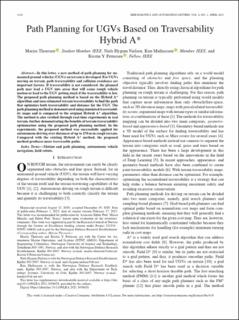| dc.contributor.author | Thoresen, Marius | |
| dc.contributor.author | Nielsen, Niels Hygum | |
| dc.contributor.author | Mathiassen, Kim | |
| dc.contributor.author | Pettersen, Kristin Ytterstad | |
| dc.date.accessioned | 2021-02-19T11:35:12Z | |
| dc.date.available | 2021-02-19T11:35:12Z | |
| dc.date.created | 2021-02-18T10:06:02Z | |
| dc.date.issued | 2021 | |
| dc.identifier.citation | IEEE Robotics and Automation Letters. 2021, 6 (2), 1216-1223. | en_US |
| dc.identifier.issn | 2377-3766 | |
| dc.identifier.uri | https://hdl.handle.net/11250/2729188 | |
| dc.description.abstract | In this letter, a new method of path planning for unmanned ground vehicles (UGVs) on terrain is developed. For UGVs moving on terrain, path traversability and collision avoidance are important factors. If traversability is not considered, the planned path may lead a UGV into areas that will cause rough vehicle motion or lead to the UGV getting stuck if the traversability is low. The proposed path planning method is based on the Hybrid A* algorithm and uses estimated terrain traversability to find the path that optimizes both traversability and distance for the UGV. The path planning method is demonstrated using simulated traversability maps and is compared to the original Hybrid A* algorithm. The method is also verified through real-time experiments in real terrain, further demonstrating the benefits of terrain traversability optimization using the proposed path planning method. In the experiments, the proposed method was successfully applied for autonomous driving over distances of up to 270 m in rough terrain. Compared with the existing Hybrid A* method, the proposed method produces more traversable paths. | en_US |
| dc.language.iso | eng | en_US |
| dc.publisher | IEEE | en_US |
| dc.rights | Navngivelse 4.0 Internasjonal | * |
| dc.rights.uri | http://creativecommons.org/licenses/by/4.0/deed.no | * |
| dc.subject | Robotikk | en_US |
| dc.subject | Robotics | en_US |
| dc.subject | Kybernetikk | en_US |
| dc.subject | Cybernetics | en_US |
| dc.subject | Ruteplanlegging | en_US |
| dc.subject | Route planning | en_US |
| dc.subject | Ubemannede systemer | en_US |
| dc.subject | Unmanned systems | en_US |
| dc.title | Path Planning for UGVs Based on Traversability Hybrid A* | en_US |
| dc.type | Peer reviewed | en_US |
| dc.type | Journal article | en_US |
| dc.description.version | publishedVersion | en_US |
| dc.subject.nsi | VDP::Teknologi: 500 | en_US |
| dc.subject.nsi | VDP::Technology: 500 | en_US |
| dc.source.pagenumber | 1216-1223 | en_US |
| dc.source.volume | 6 | en_US |
| dc.source.journal | IEEE Robotics and Automation Letters | en_US |
| dc.source.issue | 2 | en_US |
| dc.identifier.doi | 10.1109/LRA.2021.3056028 | |
| dc.identifier.cristin | 1891190 | |
| dc.relation.project | Norges forskningsråd: 223254 | en_US |
| dc.description.localcode | This work is licensed under a Creative Commons Attribution 4.0 License. For more information, see https://creativecommons.org/licenses/by/4.0/ | en_US |
| cristin.ispublished | true | |
| cristin.fulltext | original | |
| cristin.qualitycode | 1 | |

